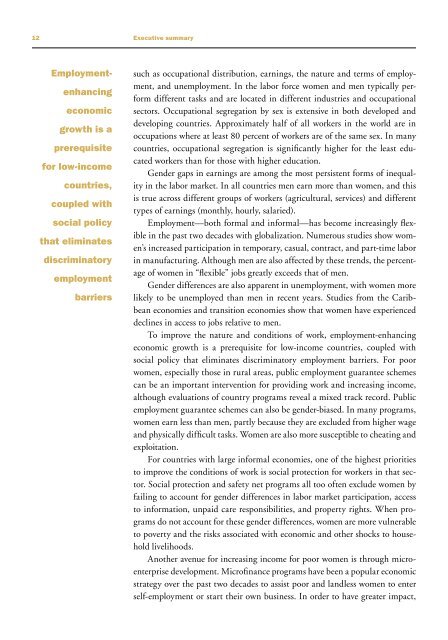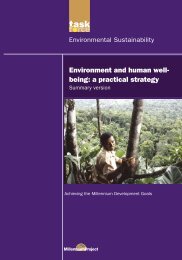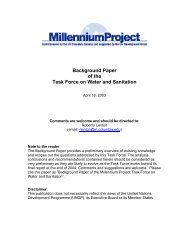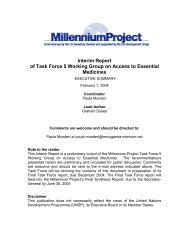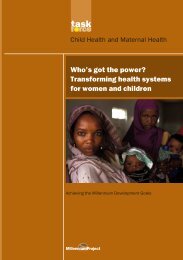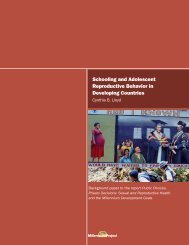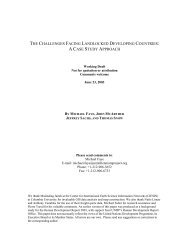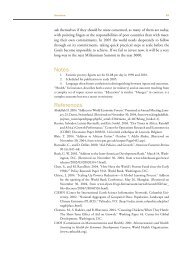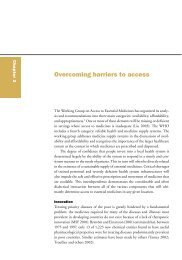Taking action: achieving gender equality and empowering women
Taking action: achieving gender equality and empowering women
Taking action: achieving gender equality and empowering women
You also want an ePaper? Increase the reach of your titles
YUMPU automatically turns print PDFs into web optimized ePapers that Google loves.
12 Executive summary<br />
Employment-<br />
enhancing<br />
economic<br />
growth is a<br />
prerequisite<br />
for low-income<br />
countries,<br />
coupled with<br />
social policy<br />
that eliminates<br />
discriminatory<br />
employment<br />
barriers<br />
such as occupational distribution, earnings, the nature <strong>and</strong> terms of employment,<br />
<strong>and</strong> unemployment. In the labor force <strong>women</strong> <strong>and</strong> men typically perform<br />
different tasks <strong>and</strong> are located in different industries <strong>and</strong> occupational<br />
sectors. Occupational segregation by sex is extensive in both developed <strong>and</strong><br />
developing countries. Approximately half of all workers in the world are in<br />
occupations where at least 80 percent of workers are of the same sex. In many<br />
countries, occupational segregation is significantly higher for the least educated<br />
workers than for those with higher education.<br />
Gender gaps in earnings are among the most persistent forms of in<strong>equality</strong><br />
in the labor market. In all countries men earn more than <strong>women</strong>, <strong>and</strong> this<br />
is true across different groups of workers (agricultural, services) <strong>and</strong> different<br />
types of earnings (monthly, hourly, salaried).<br />
Employment—both formal <strong>and</strong> informal—has become increasingly flexible<br />
in the past two decades with globalization. Numerous studies show <strong>women</strong>’s<br />
increased participation in temporary, casual, contract, <strong>and</strong> part-time labor<br />
in manufacturing. Although men are also affected by these trends, the percentage<br />
of <strong>women</strong> in “flexible” jobs greatly exceeds that of men.<br />
Gender differences are also apparent in unemployment, with <strong>women</strong> more<br />
likely to be unemployed than men in recent years. Studies from the Caribbean<br />
economies <strong>and</strong> transition economies show that <strong>women</strong> have experienced<br />
declines in access to jobs relative to men.<br />
To improve the nature <strong>and</strong> conditions of work, employment-enhancing<br />
economic growth is a prerequisite for low-income countries, coupled with<br />
social policy that eliminates discriminatory employment barriers. For poor<br />
<strong>women</strong>, especially those in rural areas, public employment guarantee schemes<br />
can be an important intervention for providing work <strong>and</strong> increasing income,<br />
although evaluations of country programs reveal a mixed track record. Public<br />
employment guarantee schemes can also be <strong>gender</strong>-biased. In many programs,<br />
<strong>women</strong> earn less than men, partly because they are excluded from higher wage<br />
<strong>and</strong> physically difficult tasks. Women are also more susceptible to cheating <strong>and</strong><br />
exploitation.<br />
For countries with large informal economies, one of the highest priorities<br />
to improve the conditions of work is social protection for workers in that sector.<br />
Social protection <strong>and</strong> safety net programs all too often exclude <strong>women</strong> by<br />
failing to account for <strong>gender</strong> differences in labor market participation, access<br />
to information, unpaid care responsibilities, <strong>and</strong> property rights. When programs<br />
do not account for these <strong>gender</strong> differences, <strong>women</strong> are more vulnerable<br />
to poverty <strong>and</strong> the risks associated with economic <strong>and</strong> other shocks to household<br />
livelihoods.<br />
Another avenue for increasing income for poor <strong>women</strong> is through microenterprise<br />
development. Microfinance programs have been a popular economic<br />
strategy over the past two decades to assist poor <strong>and</strong> l<strong>and</strong>less <strong>women</strong> to enter<br />
self-employment or start their own business. In order to have greater impact,


